Public Health: Diabetes Among Aboriginal and Torres Strait Islanders
VerifiedAdded on 2023/01/18
|8
|1661
|52
Report
AI Summary
This report examines the critical public health issue of diabetes among Aboriginal and Torres Strait Islander people in Australia, highlighting the disproportionately high prevalence and mortality rates within this population. It identifies key factors contributing to the problem, including lifestyle, social, and cultural contexts, with a particular emphasis on the higher impact on women and older individuals. The report analyzes both proximal determinants such as high blood cholesterol, obesity, and lack of physical activity, and distal determinants like poor diet and smoking habits. It also touches upon intervention strategies needed to address this health disparity and reduce diabetes-related mortality. Desklib offers this and many other solved assignments for students.
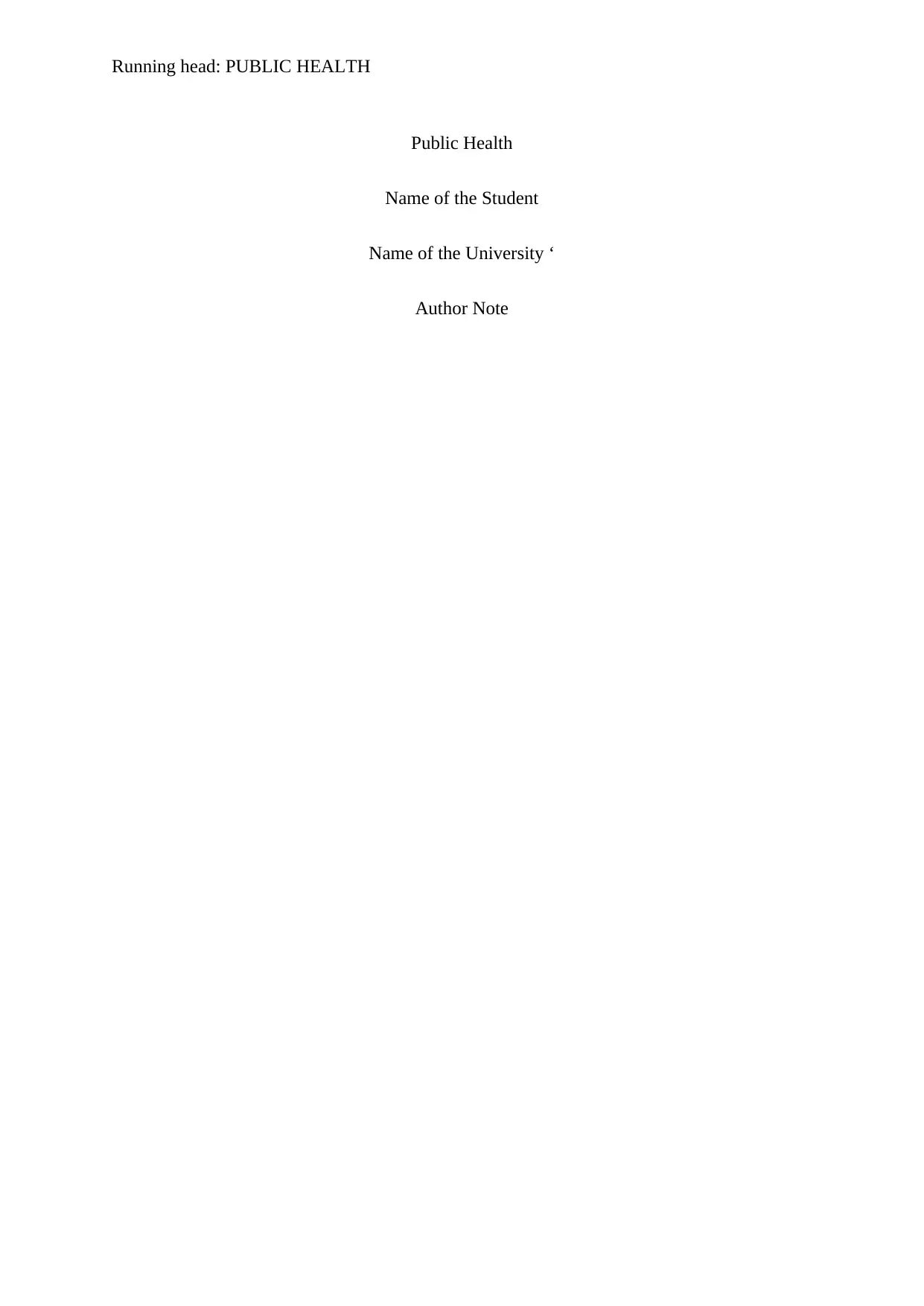
Running head: PUBLIC HEALTH
Public Health
Name of the Student
Name of the University ‘
Author Note
Public Health
Name of the Student
Name of the University ‘
Author Note
Paraphrase This Document
Need a fresh take? Get an instant paraphrase of this document with our AI Paraphraser
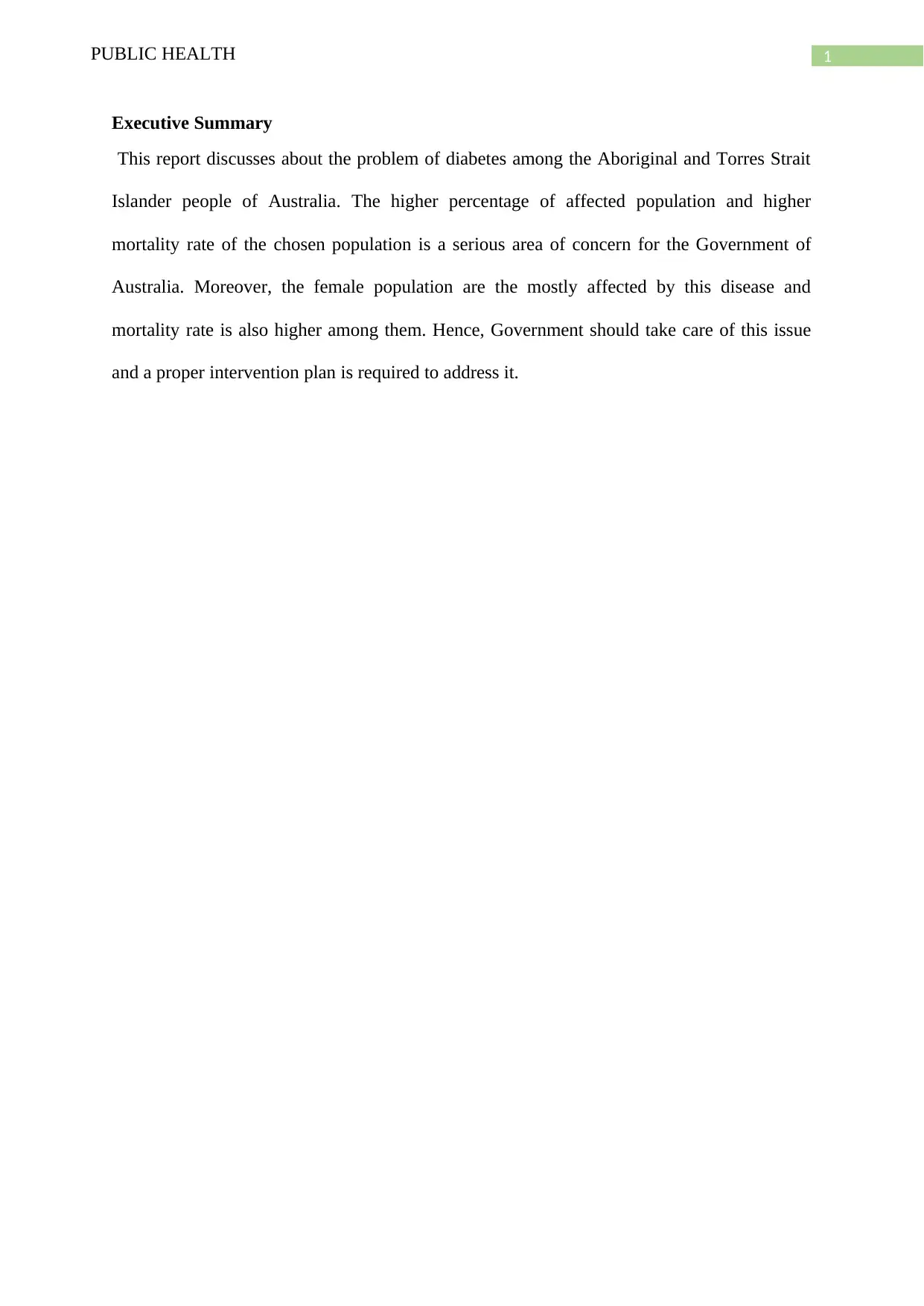
1PUBLIC HEALTH
Executive Summary
This report discusses about the problem of diabetes among the Aboriginal and Torres Strait
Islander people of Australia. The higher percentage of affected population and higher
mortality rate of the chosen population is a serious area of concern for the Government of
Australia. Moreover, the female population are the mostly affected by this disease and
mortality rate is also higher among them. Hence, Government should take care of this issue
and a proper intervention plan is required to address it.
Executive Summary
This report discusses about the problem of diabetes among the Aboriginal and Torres Strait
Islander people of Australia. The higher percentage of affected population and higher
mortality rate of the chosen population is a serious area of concern for the Government of
Australia. Moreover, the female population are the mostly affected by this disease and
mortality rate is also higher among them. Hence, Government should take care of this issue
and a proper intervention plan is required to address it.
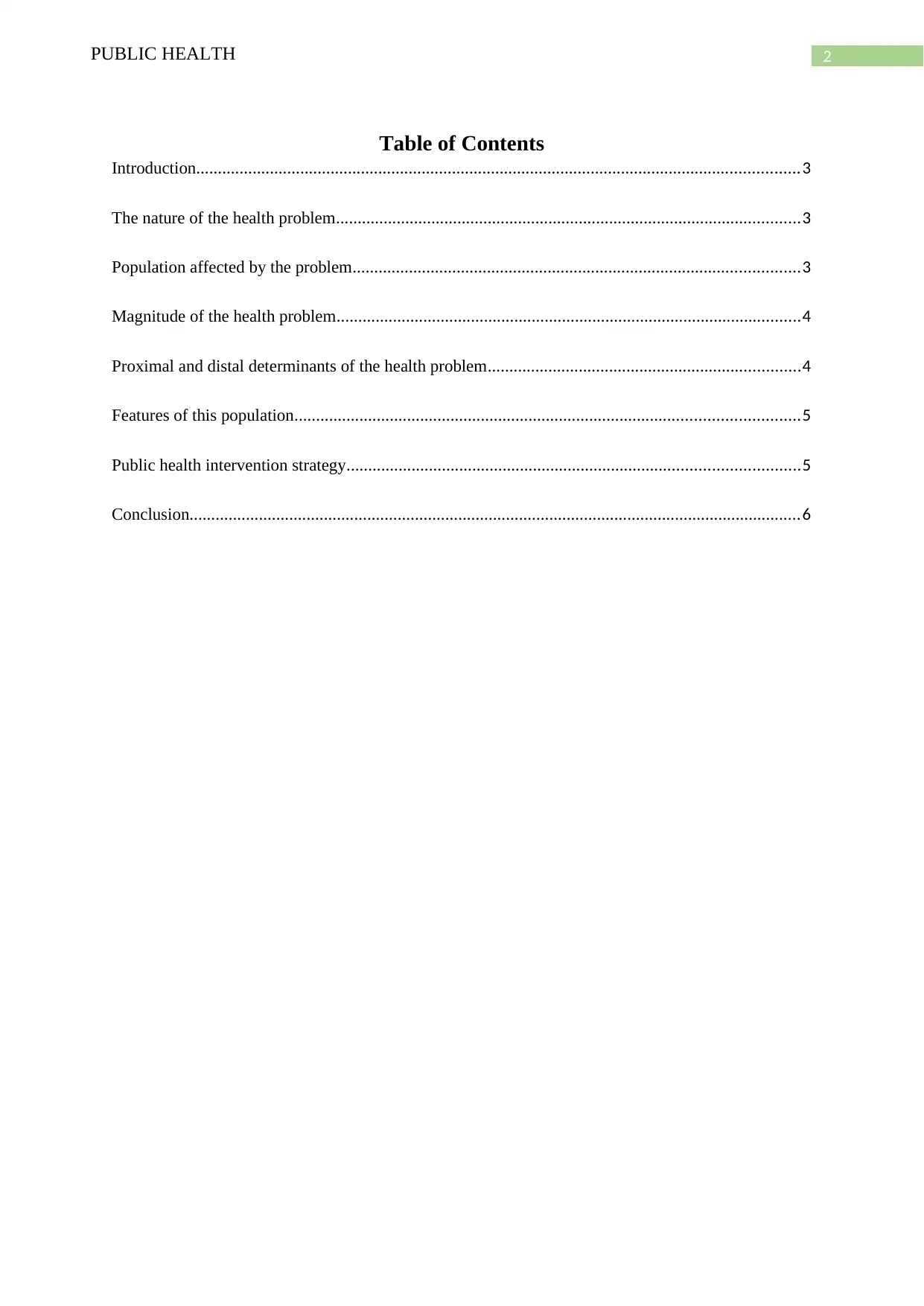
2PUBLIC HEALTH
Table of Contents
Introduction...........................................................................................................................................3
The nature of the health problem...........................................................................................................3
Population affected by the problem.......................................................................................................3
Magnitude of the health problem...........................................................................................................4
Proximal and distal determinants of the health problem........................................................................4
Features of this population....................................................................................................................5
Public health intervention strategy........................................................................................................5
Conclusion.............................................................................................................................................6
Table of Contents
Introduction...........................................................................................................................................3
The nature of the health problem...........................................................................................................3
Population affected by the problem.......................................................................................................3
Magnitude of the health problem...........................................................................................................4
Proximal and distal determinants of the health problem........................................................................4
Features of this population....................................................................................................................5
Public health intervention strategy........................................................................................................5
Conclusion.............................................................................................................................................6
⊘ This is a preview!⊘
Do you want full access?
Subscribe today to unlock all pages.

Trusted by 1+ million students worldwide
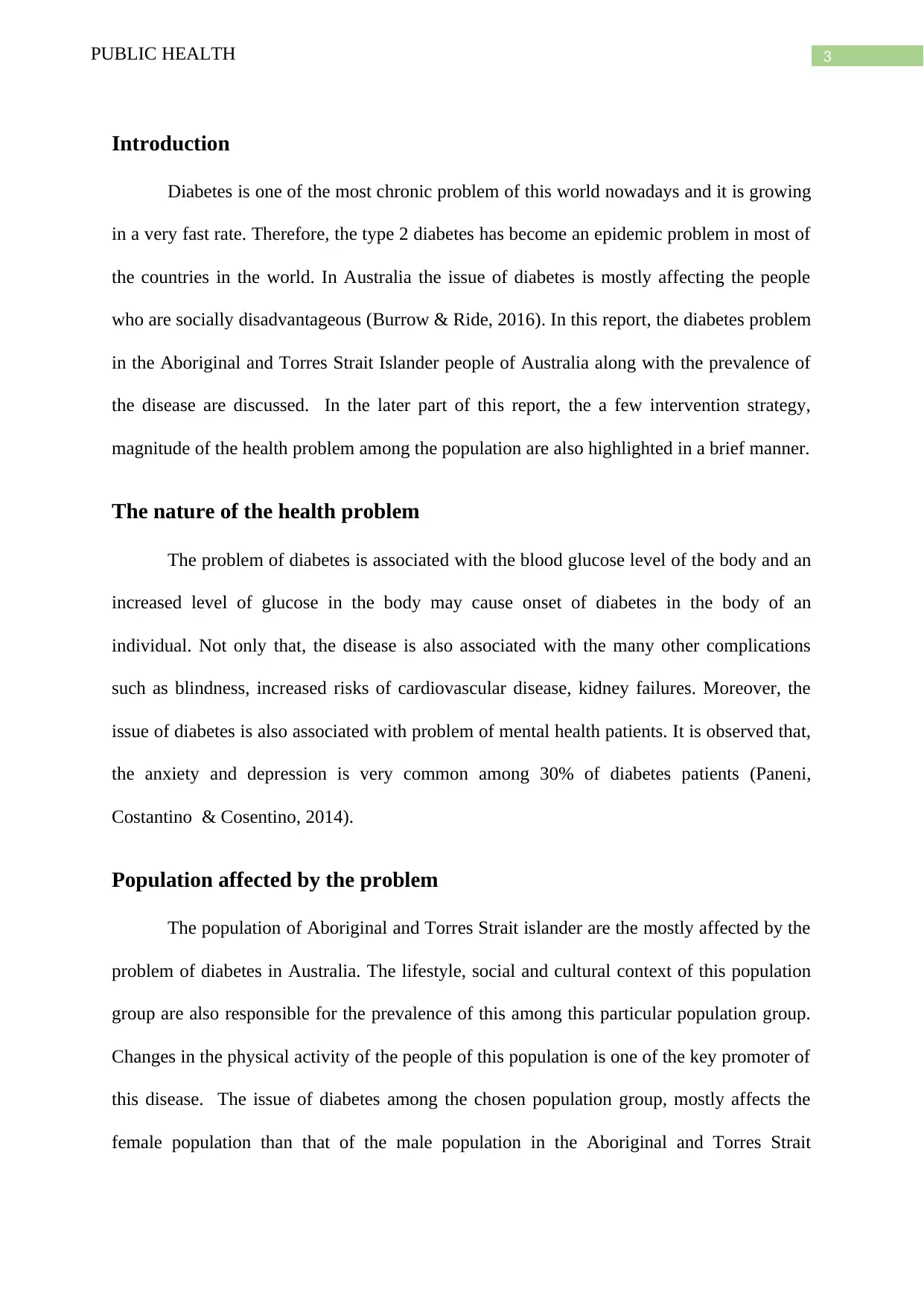
3PUBLIC HEALTH
Introduction
Diabetes is one of the most chronic problem of this world nowadays and it is growing
in a very fast rate. Therefore, the type 2 diabetes has become an epidemic problem in most of
the countries in the world. In Australia the issue of diabetes is mostly affecting the people
who are socially disadvantageous (Burrow & Ride, 2016). In this report, the diabetes problem
in the Aboriginal and Torres Strait Islander people of Australia along with the prevalence of
the disease are discussed. In the later part of this report, the a few intervention strategy,
magnitude of the health problem among the population are also highlighted in a brief manner.
The nature of the health problem
The problem of diabetes is associated with the blood glucose level of the body and an
increased level of glucose in the body may cause onset of diabetes in the body of an
individual. Not only that, the disease is also associated with the many other complications
such as blindness, increased risks of cardiovascular disease, kidney failures. Moreover, the
issue of diabetes is also associated with problem of mental health patients. It is observed that,
the anxiety and depression is very common among 30% of diabetes patients (Paneni,
Costantino & Cosentino, 2014).
Population affected by the problem
The population of Aboriginal and Torres Strait islander are the mostly affected by the
problem of diabetes in Australia. The lifestyle, social and cultural context of this population
group are also responsible for the prevalence of this among this particular population group.
Changes in the physical activity of the people of this population is one of the key promoter of
this disease. The issue of diabetes among the chosen population group, mostly affects the
female population than that of the male population in the Aboriginal and Torres Strait
Introduction
Diabetes is one of the most chronic problem of this world nowadays and it is growing
in a very fast rate. Therefore, the type 2 diabetes has become an epidemic problem in most of
the countries in the world. In Australia the issue of diabetes is mostly affecting the people
who are socially disadvantageous (Burrow & Ride, 2016). In this report, the diabetes problem
in the Aboriginal and Torres Strait Islander people of Australia along with the prevalence of
the disease are discussed. In the later part of this report, the a few intervention strategy,
magnitude of the health problem among the population are also highlighted in a brief manner.
The nature of the health problem
The problem of diabetes is associated with the blood glucose level of the body and an
increased level of glucose in the body may cause onset of diabetes in the body of an
individual. Not only that, the disease is also associated with the many other complications
such as blindness, increased risks of cardiovascular disease, kidney failures. Moreover, the
issue of diabetes is also associated with problem of mental health patients. It is observed that,
the anxiety and depression is very common among 30% of diabetes patients (Paneni,
Costantino & Cosentino, 2014).
Population affected by the problem
The population of Aboriginal and Torres Strait islander are the mostly affected by the
problem of diabetes in Australia. The lifestyle, social and cultural context of this population
group are also responsible for the prevalence of this among this particular population group.
Changes in the physical activity of the people of this population is one of the key promoter of
this disease. The issue of diabetes among the chosen population group, mostly affects the
female population than that of the male population in the Aboriginal and Torres Strait
Paraphrase This Document
Need a fresh take? Get an instant paraphrase of this document with our AI Paraphraser
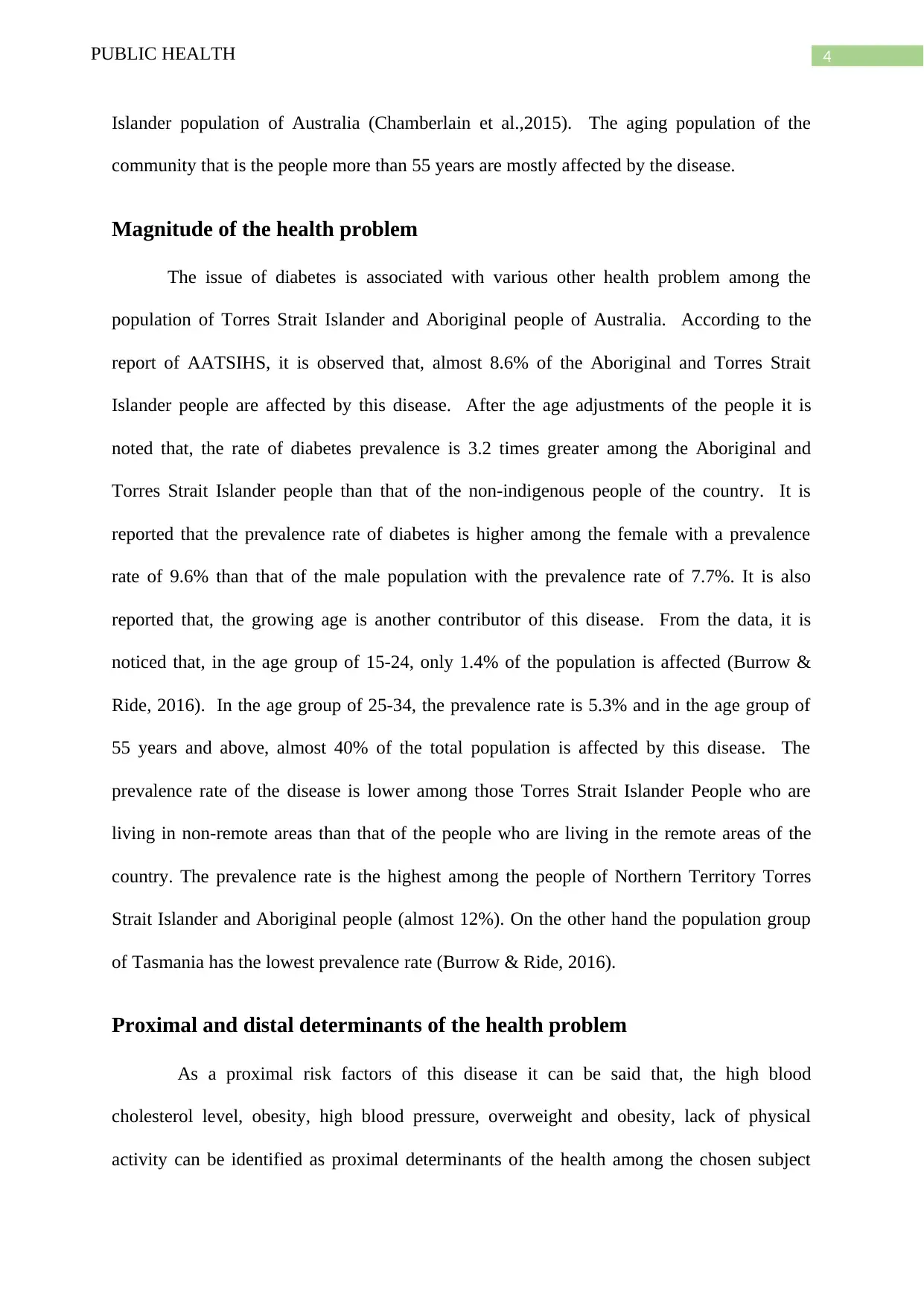
4PUBLIC HEALTH
Islander population of Australia (Chamberlain et al.,2015). The aging population of the
community that is the people more than 55 years are mostly affected by the disease.
Magnitude of the health problem
The issue of diabetes is associated with various other health problem among the
population of Torres Strait Islander and Aboriginal people of Australia. According to the
report of AATSIHS, it is observed that, almost 8.6% of the Aboriginal and Torres Strait
Islander people are affected by this disease. After the age adjustments of the people it is
noted that, the rate of diabetes prevalence is 3.2 times greater among the Aboriginal and
Torres Strait Islander people than that of the non-indigenous people of the country. It is
reported that the prevalence rate of diabetes is higher among the female with a prevalence
rate of 9.6% than that of the male population with the prevalence rate of 7.7%. It is also
reported that, the growing age is another contributor of this disease. From the data, it is
noticed that, in the age group of 15-24, only 1.4% of the population is affected (Burrow &
Ride, 2016). In the age group of 25-34, the prevalence rate is 5.3% and in the age group of
55 years and above, almost 40% of the total population is affected by this disease. The
prevalence rate of the disease is lower among those Torres Strait Islander People who are
living in non-remote areas than that of the people who are living in the remote areas of the
country. The prevalence rate is the highest among the people of Northern Territory Torres
Strait Islander and Aboriginal people (almost 12%). On the other hand the population group
of Tasmania has the lowest prevalence rate (Burrow & Ride, 2016).
Proximal and distal determinants of the health problem
As a proximal risk factors of this disease it can be said that, the high blood
cholesterol level, obesity, high blood pressure, overweight and obesity, lack of physical
activity can be identified as proximal determinants of the health among the chosen subject
Islander population of Australia (Chamberlain et al.,2015). The aging population of the
community that is the people more than 55 years are mostly affected by the disease.
Magnitude of the health problem
The issue of diabetes is associated with various other health problem among the
population of Torres Strait Islander and Aboriginal people of Australia. According to the
report of AATSIHS, it is observed that, almost 8.6% of the Aboriginal and Torres Strait
Islander people are affected by this disease. After the age adjustments of the people it is
noted that, the rate of diabetes prevalence is 3.2 times greater among the Aboriginal and
Torres Strait Islander people than that of the non-indigenous people of the country. It is
reported that the prevalence rate of diabetes is higher among the female with a prevalence
rate of 9.6% than that of the male population with the prevalence rate of 7.7%. It is also
reported that, the growing age is another contributor of this disease. From the data, it is
noticed that, in the age group of 15-24, only 1.4% of the population is affected (Burrow &
Ride, 2016). In the age group of 25-34, the prevalence rate is 5.3% and in the age group of
55 years and above, almost 40% of the total population is affected by this disease. The
prevalence rate of the disease is lower among those Torres Strait Islander People who are
living in non-remote areas than that of the people who are living in the remote areas of the
country. The prevalence rate is the highest among the people of Northern Territory Torres
Strait Islander and Aboriginal people (almost 12%). On the other hand the population group
of Tasmania has the lowest prevalence rate (Burrow & Ride, 2016).
Proximal and distal determinants of the health problem
As a proximal risk factors of this disease it can be said that, the high blood
cholesterol level, obesity, high blood pressure, overweight and obesity, lack of physical
activity can be identified as proximal determinants of the health among the chosen subject
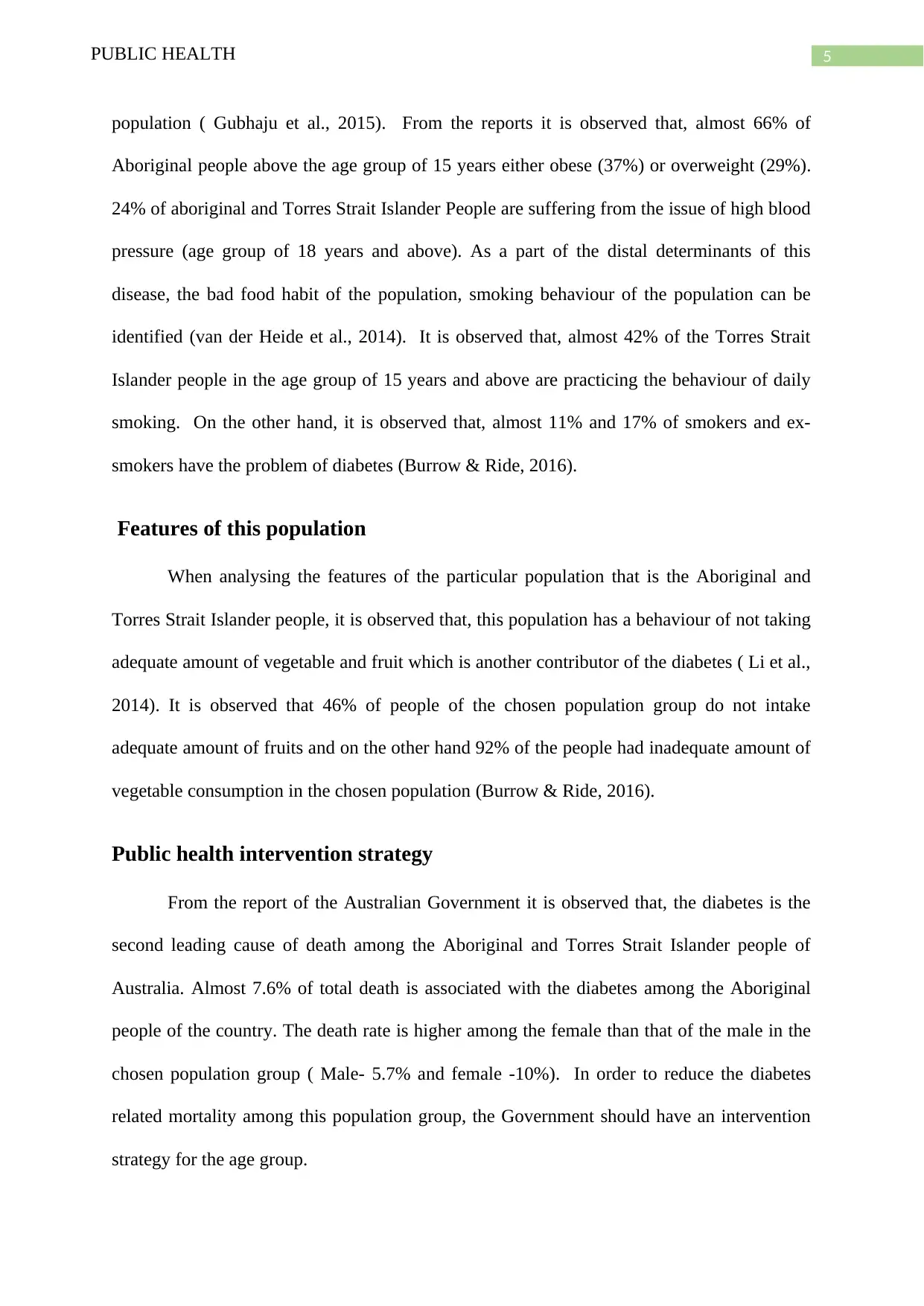
5PUBLIC HEALTH
population ( Gubhaju et al., 2015). From the reports it is observed that, almost 66% of
Aboriginal people above the age group of 15 years either obese (37%) or overweight (29%).
24% of aboriginal and Torres Strait Islander People are suffering from the issue of high blood
pressure (age group of 18 years and above). As a part of the distal determinants of this
disease, the bad food habit of the population, smoking behaviour of the population can be
identified (van der Heide et al., 2014). It is observed that, almost 42% of the Torres Strait
Islander people in the age group of 15 years and above are practicing the behaviour of daily
smoking. On the other hand, it is observed that, almost 11% and 17% of smokers and ex-
smokers have the problem of diabetes (Burrow & Ride, 2016).
Features of this population
When analysing the features of the particular population that is the Aboriginal and
Torres Strait Islander people, it is observed that, this population has a behaviour of not taking
adequate amount of vegetable and fruit which is another contributor of the diabetes ( Li et al.,
2014). It is observed that 46% of people of the chosen population group do not intake
adequate amount of fruits and on the other hand 92% of the people had inadequate amount of
vegetable consumption in the chosen population (Burrow & Ride, 2016).
Public health intervention strategy
From the report of the Australian Government it is observed that, the diabetes is the
second leading cause of death among the Aboriginal and Torres Strait Islander people of
Australia. Almost 7.6% of total death is associated with the diabetes among the Aboriginal
people of the country. The death rate is higher among the female than that of the male in the
chosen population group ( Male- 5.7% and female -10%). In order to reduce the diabetes
related mortality among this population group, the Government should have an intervention
strategy for the age group.
population ( Gubhaju et al., 2015). From the reports it is observed that, almost 66% of
Aboriginal people above the age group of 15 years either obese (37%) or overweight (29%).
24% of aboriginal and Torres Strait Islander People are suffering from the issue of high blood
pressure (age group of 18 years and above). As a part of the distal determinants of this
disease, the bad food habit of the population, smoking behaviour of the population can be
identified (van der Heide et al., 2014). It is observed that, almost 42% of the Torres Strait
Islander people in the age group of 15 years and above are practicing the behaviour of daily
smoking. On the other hand, it is observed that, almost 11% and 17% of smokers and ex-
smokers have the problem of diabetes (Burrow & Ride, 2016).
Features of this population
When analysing the features of the particular population that is the Aboriginal and
Torres Strait Islander people, it is observed that, this population has a behaviour of not taking
adequate amount of vegetable and fruit which is another contributor of the diabetes ( Li et al.,
2014). It is observed that 46% of people of the chosen population group do not intake
adequate amount of fruits and on the other hand 92% of the people had inadequate amount of
vegetable consumption in the chosen population (Burrow & Ride, 2016).
Public health intervention strategy
From the report of the Australian Government it is observed that, the diabetes is the
second leading cause of death among the Aboriginal and Torres Strait Islander people of
Australia. Almost 7.6% of total death is associated with the diabetes among the Aboriginal
people of the country. The death rate is higher among the female than that of the male in the
chosen population group ( Male- 5.7% and female -10%). In order to reduce the diabetes
related mortality among this population group, the Government should have an intervention
strategy for the age group.
⊘ This is a preview!⊘
Do you want full access?
Subscribe today to unlock all pages.

Trusted by 1+ million students worldwide
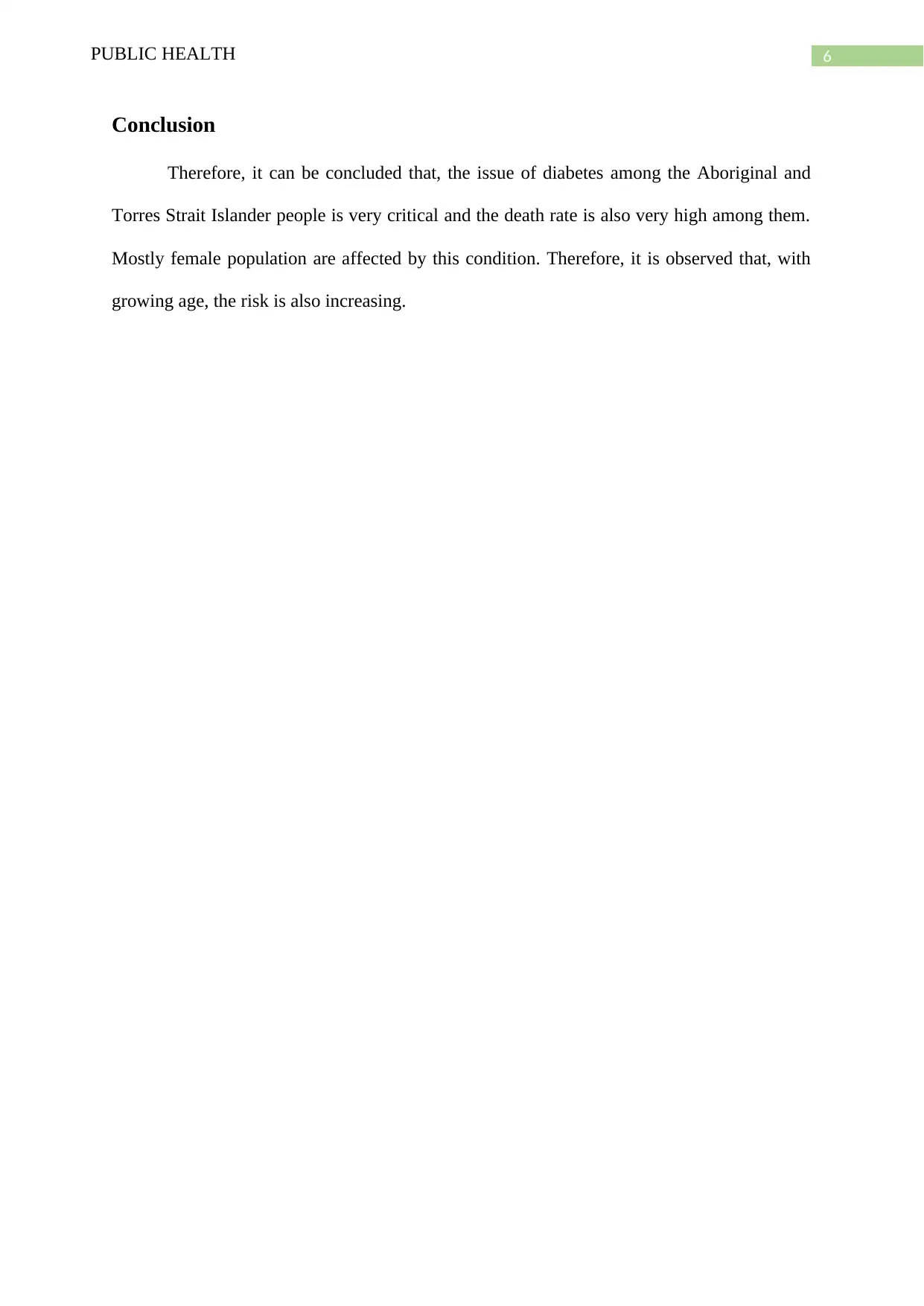
6PUBLIC HEALTH
Conclusion
Therefore, it can be concluded that, the issue of diabetes among the Aboriginal and
Torres Strait Islander people is very critical and the death rate is also very high among them.
Mostly female population are affected by this condition. Therefore, it is observed that, with
growing age, the risk is also increasing.
Conclusion
Therefore, it can be concluded that, the issue of diabetes among the Aboriginal and
Torres Strait Islander people is very critical and the death rate is also very high among them.
Mostly female population are affected by this condition. Therefore, it is observed that, with
growing age, the risk is also increasing.
Paraphrase This Document
Need a fresh take? Get an instant paraphrase of this document with our AI Paraphraser
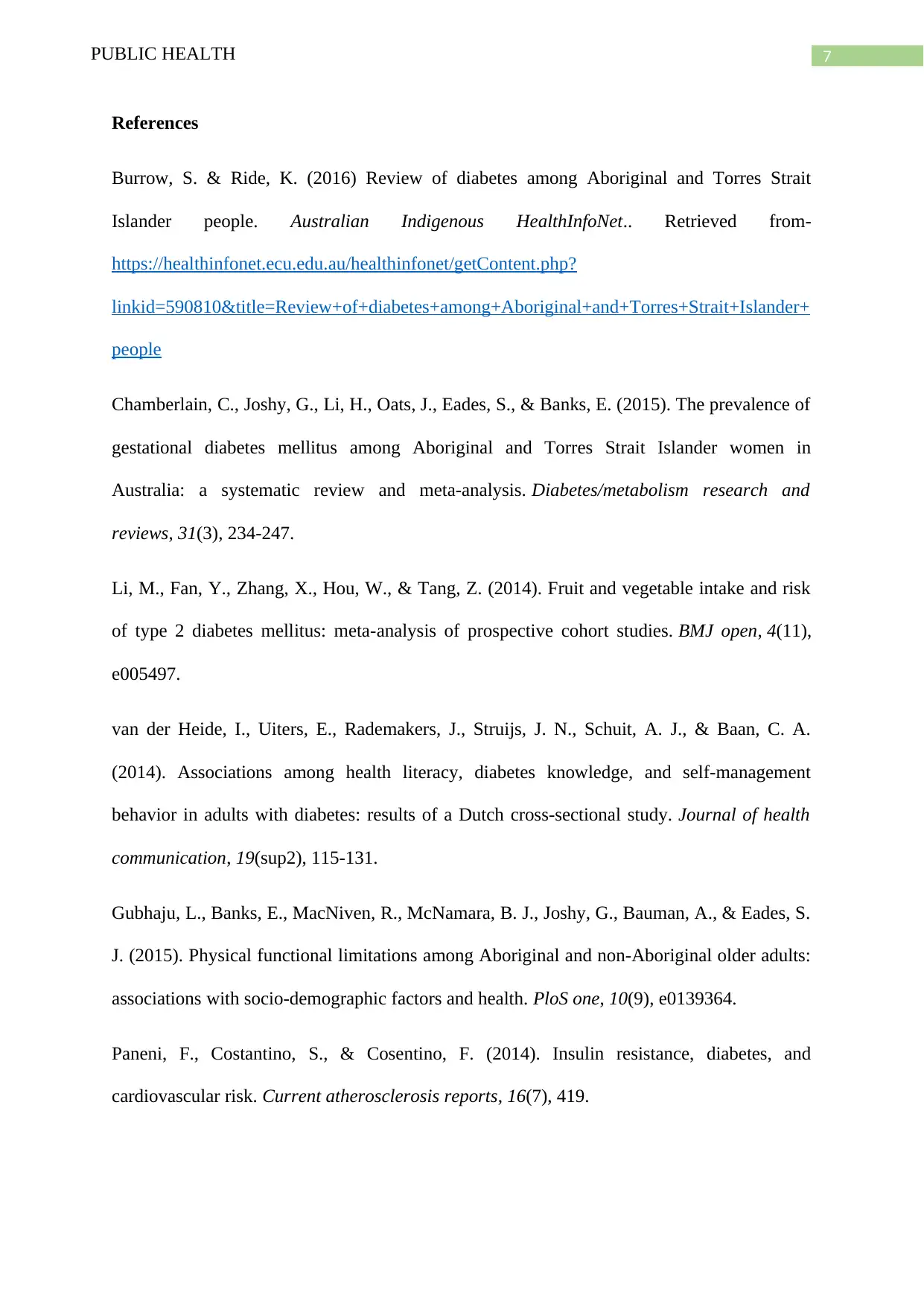
7PUBLIC HEALTH
References
Burrow, S. & Ride, K. (2016) Review of diabetes among Aboriginal and Torres Strait
Islander people. Australian Indigenous HealthInfoNet.. Retrieved from-
https://healthinfonet.ecu.edu.au/healthinfonet/getContent.php?
linkid=590810&title=Review+of+diabetes+among+Aboriginal+and+Torres+Strait+Islander+
people
Chamberlain, C., Joshy, G., Li, H., Oats, J., Eades, S., & Banks, E. (2015). The prevalence of
gestational diabetes mellitus among Aboriginal and Torres Strait Islander women in
Australia: a systematic review and meta‐analysis. Diabetes/metabolism research and
reviews, 31(3), 234-247.
Li, M., Fan, Y., Zhang, X., Hou, W., & Tang, Z. (2014). Fruit and vegetable intake and risk
of type 2 diabetes mellitus: meta-analysis of prospective cohort studies. BMJ open, 4(11),
e005497.
van der Heide, I., Uiters, E., Rademakers, J., Struijs, J. N., Schuit, A. J., & Baan, C. A.
(2014). Associations among health literacy, diabetes knowledge, and self-management
behavior in adults with diabetes: results of a Dutch cross-sectional study. Journal of health
communication, 19(sup2), 115-131.
Gubhaju, L., Banks, E., MacNiven, R., McNamara, B. J., Joshy, G., Bauman, A., & Eades, S.
J. (2015). Physical functional limitations among Aboriginal and non-Aboriginal older adults:
associations with socio-demographic factors and health. PloS one, 10(9), e0139364.
Paneni, F., Costantino, S., & Cosentino, F. (2014). Insulin resistance, diabetes, and
cardiovascular risk. Current atherosclerosis reports, 16(7), 419.
References
Burrow, S. & Ride, K. (2016) Review of diabetes among Aboriginal and Torres Strait
Islander people. Australian Indigenous HealthInfoNet.. Retrieved from-
https://healthinfonet.ecu.edu.au/healthinfonet/getContent.php?
linkid=590810&title=Review+of+diabetes+among+Aboriginal+and+Torres+Strait+Islander+
people
Chamberlain, C., Joshy, G., Li, H., Oats, J., Eades, S., & Banks, E. (2015). The prevalence of
gestational diabetes mellitus among Aboriginal and Torres Strait Islander women in
Australia: a systematic review and meta‐analysis. Diabetes/metabolism research and
reviews, 31(3), 234-247.
Li, M., Fan, Y., Zhang, X., Hou, W., & Tang, Z. (2014). Fruit and vegetable intake and risk
of type 2 diabetes mellitus: meta-analysis of prospective cohort studies. BMJ open, 4(11),
e005497.
van der Heide, I., Uiters, E., Rademakers, J., Struijs, J. N., Schuit, A. J., & Baan, C. A.
(2014). Associations among health literacy, diabetes knowledge, and self-management
behavior in adults with diabetes: results of a Dutch cross-sectional study. Journal of health
communication, 19(sup2), 115-131.
Gubhaju, L., Banks, E., MacNiven, R., McNamara, B. J., Joshy, G., Bauman, A., & Eades, S.
J. (2015). Physical functional limitations among Aboriginal and non-Aboriginal older adults:
associations with socio-demographic factors and health. PloS one, 10(9), e0139364.
Paneni, F., Costantino, S., & Cosentino, F. (2014). Insulin resistance, diabetes, and
cardiovascular risk. Current atherosclerosis reports, 16(7), 419.
1 out of 8
Related Documents
Your All-in-One AI-Powered Toolkit for Academic Success.
+13062052269
info@desklib.com
Available 24*7 on WhatsApp / Email
![[object Object]](/_next/static/media/star-bottom.7253800d.svg)
Unlock your academic potential
Copyright © 2020–2025 A2Z Services. All Rights Reserved. Developed and managed by ZUCOL.





